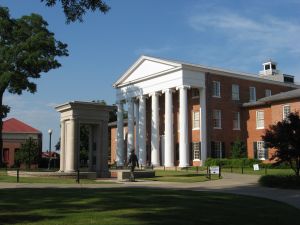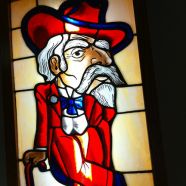Symbols of the Civil War at the University of Mississippi
One of the burdens of Southern history—to borrow from the title of C. Vann Woodward’s fine book—is that the University of Mississippi seems condemned to wrestle into eternity with 150-year-old symbols of the Civil War.
The latest episode in the saga occurred in September 2014 when the Mississippi division of the Sons of Confederate Veterans went to court in an effort to obtain an injunction against the school’s move to change the name of a campus street from Confederate Drive to Chapel Lane.
The case is still pending, but the university is moving ahead with the name change and taking other steps to alter its image as a shrine for the Old South. Because of the racial implications of some of the symbols, the school’s administration intends to deemphasize them and turn the Oxford campus into a more comfortable home for its steadily growing numbers of black students. When the administration revealed in summer 2013 a list of recommendations by outside consultants to foster a “more inclusive” environment, Kim Dandridge—a symbol herself as the first African American woman to be elected president of the student body—said, “It’s great to see the university move forward to make it a more diverse place. It makes Ole Miss a more welcoming place.”
However, those who want to keep the “Confederate” in the street name—many of whom still enjoy political influence—expressed indignation over what they perceive as an assault on Southern heritage. Their objections gained strength after the report spoke of the “appropriate use” of the nickname “Ole Miss.” Fears were fanned that the nickname would be officially dropped. (Though generations of alumni and friends of the school have affectionately called the university “Ole Miss,” it has drawn objections because the term is believed to be descended from a nineteenth-century expression black workers used for the matriarch of the plantation.)
The claim that “Ole Miss” would end up on the dustbin of history proved to be a false alarm. The school has indicated that “University of Mississippi” will be applied more often to academic situations, and “Ole Miss” will continue to be attached to athletic teams and serve as a rallying cry for school spirit.
For more than fifty years, the school has been recovering from the legacy of what happened on campus in 1962, when segregationist politicians seized control of the university in a vain attempt to defy federal court orders and prevent the admission of its first black student. When James Meredith arrived on campus, a riot ensued that claimed two lives and injured hundreds. Upwards of thirty thousand troops had to be deployed to restore order. The university’s reputation suffered, and enrollment plummeted.

Civil Rights Memorial and the Lyceum. University of Mississippi, Oxford. Photo by Joseph. http://tinyurl.com/mhsefn3
Visionary leaders eventually regained control of the Lyceum—the antebellum building that contains the offices of the university’s administration.
The new battle over symbols began two decades ago with the university’s decision to disassociate itself from the Confederate battle flag; it continued over the elimination of Colonel Rebel as the school’s mascot and official disapproval of students shouting “The South Will Rise Again!” at football games. The emotional struggle has already gone on five times longer than the Civil War lasted.
Shortly before the kickoff at the Music City Bowl game in Nashville last season, where the Ole Miss football team defeated Georgia Tech, a fan bearing a key ring with a miniature Colonel Rebel figure approached Dan Jones, the university chancellor, and asked, “What are we going to do with this?” The chancellor responded, diplomatically, that the symbol was worthy of a place in a museum, but no longer appropriate as a modern representative of the school.
Jones’s answer failed to appease many of the school’s followers who still cling to what they call their “tradition” and their “heritage.”
During the first half of the twentieth century, Ole Miss functioned as an all-white, flagship university for a state governed by segregationists prepared to fight Washington to the last ditch to resist the Supreme Court’s decision to outlaw segregation in public schools. The institution was considered the most Southern of all the schools in Dixie. The Ole Miss band wore uniforms tailored after the Confederate army gray and frequently tootled “Dixie.” Cheerleaders punctuated their activities by waving Confederate battle flags, and at halftime of football games, a monstrously large flag of red and blue with stars and bars was paraded across the field.
The flag became an even more potent symbol immediately after the bloody showdown between state authorities and the federal government over the integration of Ole Miss. To defy President John F. Kennedy, state agencies purchased thousands of battle flags and distributed them at Ole Miss football games. Like fields of crocuses in the springtime, flags began to blossom in the stadium and continued to be conspicuous into the 1990s.
But like the Confederacy, the symbols began to lose power after it became apparent that celebrations of the “Lost Cause” were counterproductive. Though a towering Confederate monument holds a prominent place on campus, just as similar statues occupy courthouse lawns across the South, there have been changes.
In one of the most dramatic gestures, the University of Mississippi erected in 2007 a civil rights memorial with a statue of Meredith, the man who broke the school’s color barrier. While a racially mixed audience of hundreds listened, Morgan Freeman, a Mississippian who would have been denied entry to Ole Miss when he graduated from high school a half-century before, spoke at dedication ceremonies along with Congressman John Lewis of Georgia, one of the heroes of the civil rights movement.
Even so, passions for the Confederacy, like old soldiers, refuse to die—or fade away quietly—and the modern history of the school is speckled with skirmishes.
Since becoming chancellor in 2009, Jones has been forced to deal repeatedly with Confederate issues. He presided over the formal switch in school mascots from that of Colonel Rebel, an ersatz plantation master with a white goatee and traditional hat, to a black bear. (The bear has failed to win an enthusiastic reception.) Jones also warned students to stop chanting “The South Will Rise Again!” during the closing bars of the “Battle Hymn of the Republic,” played at football games in concert with “Dixie.” When the noise persisted in the student section, the band was instructed to stop playing the anthem.
Jones’s predecessor, Robert Khayat, first tackled the symbology after he determined they had a damaging impact on the university’s national image. “We need to get rid of negative perceptions,” Khayat said at the time. “They impede our mission and our destiny.”
Following a losing football season in 1996, the coach complained that he was unable to recruit promising black high school athletes because of the display of Confederate battle flags at Ole Miss football games.
Khayat took dead aim at the flags and succeeded in cleansing the stadium with an imaginative order. Knowing he could not block a spectator’s First Amendment right to wave a banner, he instead outlawed stick-like instruments, including sticks attached to the flags. The ruling eliminated the sale of corn dogs and the use of umbrellas in the stadium, but it also got rid of the flags.
Khayat realized there was more to do, and he created a sweeping review of the symbols. In his 2013 memoir, The Education of a Lifetime, Khayat wrote, “Everything seemed to be on the table for discussion—from self-perception to academic programs, street signs to architecture, and landscaping to mascots.”
Khayat said he failed to realize that the original story about his initiative in the campus newspaper, The Daily Mississippian, “would spark a media firestorm.” But it did, and nearly twenty years later, the fire still burns.
Incidents that might take place without much notice at, say, the University of Minnesota, provoke headlines across the country if they occur at the University of Mississippi.
When a couple of students from Georgia thought it would be cute—apparently after an all-night party—to decorate the Meredith statue last February with a noose and an out-of-date Georgia state flag that bore an emblem of the Confederacy, the prank attracted nationwide attention. Student privacy rights prevent the university from announcing its disciplinary action, but none of the students are believed to be still enrolled.
Earlier in the decade, journalists flocked to the campus to report on the demise of Colonel Rebel and the transfer of the mascot’s mantle to a black bear, the victor in a referendum involving students and alumni. Since the colonel was not included in a list of candidates to become the new mascot, neo-Confederate interests cried foul.
Some disgruntled alumni cut off their contributions to the athletic program. Instead, they channeled their money into a well-funded movement called “Forward Rebels” that helped drive athletic director Pete Boone, who supported the transition in mascots, to resign in 2011. It was one of the few victories achieved by the friends of the symbols.
In The Burden of Southern History, published in 1960, Woodward wrote: “One by one, in astonishingly rapid succession, many landmarks of racial discrimination and segregation have disappeared, and old barriers have been breached.” But he warned, “Many remain, of course—perhaps more than have been breached—and distinctively Southern racial attitudes will linger for a long time.”
At Ole Miss, those who support holding on to the symbols of the past have been reduced to a distinct minority, but the battle is still being played out well into the twenty-first century.








Thank you for the fight from within. It is hard to be seen as something of a traitor to your own culture and institutions, but you do a great job of showing loyalty and affection while demanding that Ol’ Miss and our many southern institutions be what they claim to be